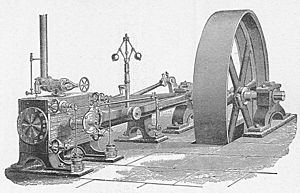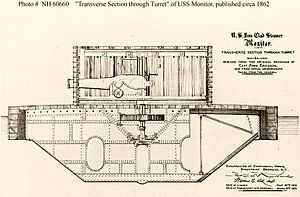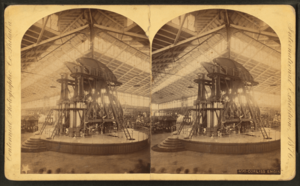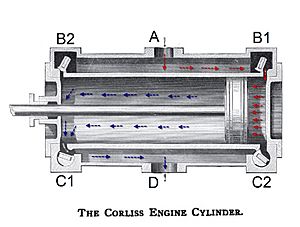George Henry Corliss facts for kids
George Henry Corliss (born June 2, 1817 – died February 21, 1888) was an American mechanical engineer and inventor. He created the Corliss steam engine, which was a huge improvement over other stationary steam engines of his time. Many people consider the Corliss engine one of the most important engineering achievements of the 1800s. It gave factories a strong and efficient power source. This helped new factories grow in places that didn't have much water power. Corliss became famous around the world for his work. He is perhaps best known for the Centennial Engine, a giant machine that was the main attraction at the 1876 Centennial Exposition in Philadelphia.
Contents
Early Life and Mechanical Skills
George Henry Corliss was born on June 2, 1817, in Easton, New York. He was the second child of Dr. Hiram and Susan Corliss. His father was a doctor. George went to local schools until he was 14. Then, he started working in a general store in Greenwich, New York. In 1834, he went to an academy in Castleton, Vermont, and finished his studies in 1838.

George showed his mechanical talent early on. In 1837, a flood washed away a bridge in Greenwich. He helped organize local builders to put up a new bridge. After graduating in 1838, he opened his own general store in Greenwich. He ran the store for three years. In January 1839, he married Phebe F. Frost. They had two children, Maria and George, Jr.
During this time, Corliss became more interested in machines. Around 1841, he decided to focus only on his inventions. In 1842, he received a patent for a machine that could sew boots and other heavy leather.
In 1844, Corliss moved to Providence, Rhode Island. He hoped to find money to improve his sewing machine. In Providence, he worked as a draftsman for Fairbanks, Bancroft & Company. However, he soon stopped working on sewing machines. He decided to focus on making the stationary steam engine better. At that time, steam engines were not very efficient.
Building a Business and a Better Engine
In 1848, Corliss started a company called Corliss, Nightingale & Company. He partnered with John Barstow and E.J. Nightingale. In the same year, the company built its first engine using Corliss' new ideas. This engine was basically the Corliss steam engine that would become famous later. Corliss and his partners built a new factory in Providence. The company grew a lot over the years. By the time Corliss died in 1888, the factory covered about 5 acres and employed over 1,000 people.
On March 10, 1849, Corliss received a US Patent for his special valve gear. This was a key part of his engine. In 1856, the Corliss Steam Engine Company officially became a company. George Corliss was the president, and his younger brother, William, was the treasurer.
By 1859, Corliss engines were being sent to Scotland for use in cotton mills. By 1864, parts for the engines were being made in Bolton, England. Corliss managed both the business and the invention parts of his company. Over the years, he invented many ways to improve how things were made, like a machine for cutting gears. Europe soon became a big buyer of the Corliss engine. Other engine builders even copied his design and used his name for their versions.
The Corliss engine saved a lot of fuel, which was a big selling point for factories. Like other engine makers, the Corliss Steam Engine Company often set the price of their machines based on how much coal they would save.
Corliss' first wife, Phebe, died on March 5, 1859. In December 1866, he married Emily Shaw.

The Corliss Steam Engine Company also helped the United States government during the American Civil War. When the warship Monitor was being built in 1861, a large ring was needed for its spinning turret. The Corliss Engine Works was one of the few factories that could make such a large part. When Corliss learned what the part was for, he stopped other work. He ran his factory day and night to finish the important ring on time and send it to New York.
By the late 1860s, Corliss was becoming famous around the world. At the 1867 World's Fair in Paris, he won first prize. This was in a competition with one hundred of the most famous engine builders. One of the fair's leaders, John Scott Russell, said that the Corliss valve gear was "as beautiful as the human hand." He praised the engine for its smart design and excellent work.
On January 11, 1870, Corliss received the Rumford Prize. This was given by the American Academy of Arts and Sciences. On that day, Dr. Asa Gray, the president of the academy, said that "No invention since Watt's time has so enhanced the efficiency of the steam engine" as Corliss' invention.
The Centennial Engine

In 1872, the state of Rhode Island chose Corliss to help organize the Centennial Exposition in Philadelphia. He was also part of the group that planned the event. He worked very hard to arrange the fair. It was his idea to create the Centennial Board of Finance. This group helped make sure the exhibition had enough money.
Corliss also played a big part in the fair's success as an engineer. Other plans for powering the fair's machines didn't work. So, Corliss provided a huge 1,400 horsepower engine. This engine supplied all the power for the Machinery Hall.
Corliss paid one hundred thousand dollars of his own money to build and install this engine. It was the largest engine of its kind at the time. Later, this giant engine was used to power the Pullman Car Works in Chicago. It ran until 1910, when it was sold for scrap metal.
Later Years and Lasting Impact
Corliss was also active in his community. He was elected three times to the Rhode Island General Assembly. He served as a representative from North Providence from 1868 to 1870. In 1876, he was chosen to vote for president, and he voted for President Hayes. He was a Congregationalist in his religious beliefs. He gave a lot of money to his own church and to other churches.
Corliss' main patent expired in 1870. After that, many other companies started making "Corliss" engines. Companies like William A. Harris Steam Engine Company and E.P. Allis Company (which became Allis-Chalmers) made them. These machines were generally called "Corliss" engines, no matter who built them. The "Corliss-type" engine became very popular in Europe. Corliss even received a special award from the Vienna Exposition in 1873, even though he wasn't an exhibitor!
Another great honor came from the Institute of France. On March 10, 1879, they gave him the Montyon prize for mechanical achievement. This was a very important award in Europe. It was a coincidence that he received this award exactly 30 years after getting his first patent. In 1886, the King of Belgium made Corliss an officer in the Order of Leopold.
Even with all the competition, Corliss stayed involved in his company. He kept making changes to his engine design to meet new needs.
George Corliss died on February 21, 1888, at age 70. He is buried with his second wife, Emily, at Swan Point Cemetery in Providence.
The Corliss Steam Engine Company was bought by the International Power Company in 1900. In 1905, it was bought by the American and British Manufacturing Company. In 1925, the company joined with Franklin Machine Company.
The house Corliss built in 1875 in Providence is now called the Corliss-Brackett House. It is part of Brown University. Corliss Street in Providence, near where his factory used to be, is also named after him. Corliss High School in Chicago is named in his honor too.
In 2006, George Corliss was added to the National Inventors Hall of Fame.
See also
 In Spanish: George Henry Corliss para niños
In Spanish: George Henry Corliss para niños
- Corliss-Brackett House



